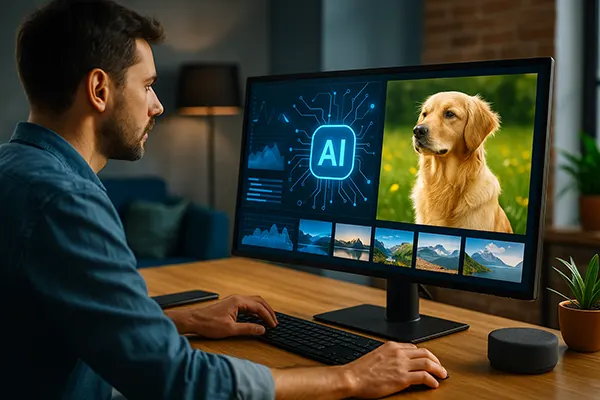
SEO for Image Search, Visual Search, and AI-Powered Discovery
Search engine optimisation (SEO) has evolved far beyond traditional keyword strategies. In 2025, image search and AI-powered visual discovery are central to how users find and interpret information online. Businesses, creators, and marketers must now optimise not only text but also images, videos, and metadata to ensure visibility across advanced search systems that rely on visual intelligence.
Understanding Image Search Optimisation in 2025
Modern image search relies on deep learning models capable of understanding context, texture, and composition rather than just filenames or alt attributes. Google Lens, Bing Visual Search, and similar tools analyse the visual components of images to match them with user intent, offering more intuitive and precise results. This means that image optimisation requires a combination of metadata accuracy, high-quality visuals, and contextual relevance.
File names, structured data, and alt text remain critical for accessibility and search indexing. However, 2025 algorithms place increasing weight on visual relevance—how well the image reflects the associated text and how effectively it serves user needs. Authentic, original imagery ranks higher than stock photos due to its contribution to E-E-A-T (Experience, Expertise, Authoritativeness, and Trustworthiness).
For effective SEO, businesses must ensure all media assets are properly labelled, compressed without quality loss, and accompanied by detailed schema markup. Including EXIF data where appropriate can enhance image indexing by providing additional metadata such as camera type, date, and location, which supports AI interpretation.
Techniques for Effective Image SEO
Adapting to AI-driven search requires a new level of precision. Each image should serve a defined informational purpose, contributing to the content’s thematic consistency. Alt text must describe the content accurately while avoiding keyword stuffing, ensuring accessibility and improving semantic understanding for search engines.
WebP and AVIF formats have become the standard for web performance due to their superior compression and quality preservation. Responsive images with SRCSET attributes allow for device-specific optimisation, which improves page experience metrics—a key ranking factor since Google’s Core Web Vitals update.
Adding image sitemaps ensures that search engines can index all visual assets, even those loaded dynamically via JavaScript. Combined with structured data, this approach provides clarity on how images relate to page content, increasing the likelihood of being displayed in rich results and featured snippets.
The Rise of Visual Search and Its Impact on SEO
Visual search has transformed how users discover information. Instead of typing queries, people now upload or scan images to find products, places, or related content. Retailers and content creators who optimise for visual search can reach audiences that traditional SEO strategies overlook, especially in e-commerce and travel sectors.
AI models used in visual search can identify patterns, colours, and objects, recognising brand logos and even product variations. Optimising for these algorithms involves consistent branding, clear product photography, and uniform lighting that allows models to distinguish visual elements with ease.
Integrating structured product data with rich visual content enhances discoverability. For example, product schema with image links, availability, and price can help images appear in AI-driven carousels. Furthermore, ensuring visual coherence across all channels—website, mobile app, and social platforms—reinforces brand authority and trust.
Adapting SEO Strategies to Visual Intent
To succeed in 2025, SEO professionals must interpret “visual intent”—what users are seeking through images rather than text. Understanding whether a user’s image search aims to buy, learn, or compare allows for content alignment that satisfies both intent and context. This requires data from image analytics tools such as Google Search Console’s image performance reports.
Using contextual captions that mirror searcher intent helps algorithms categorise visuals correctly. Pairing images with relevant structured headings also enhances their interpretability within the semantic structure of the page. Each visual element should contribute to storytelling, supporting a coherent and informative narrative.
Brands that combine technical optimisation with creative consistency—using recognisable colour palettes, typography, and framing—will perform better in AI-based visual discovery systems. Visual identity, once a branding concern, is now a measurable SEO asset.

AI Models and the Future of Image-Based Search
Artificial intelligence is reshaping the fundamentals of search behaviour. Multimodal AI systems such as Google Gemini and OpenAI’s CLIP integrate text and image data to provide context-aware results that interpret both visual and linguistic cues. This fusion makes SEO an interdisciplinary process involving linguistics, design, and data science.
AI systems assess content credibility by evaluating the authenticity of images and the consistency between visuals and textual claims. Deepfake detection and content provenance verification are now part of search quality assessment, pushing creators to prioritise transparency and originality in image creation.
By 2025, visual generative models are not merely tools for content creation—they influence how search engines categorise and recommend information. Incorporating AI-generated visuals responsibly, with clear attribution and context, enhances credibility while maintaining alignment with ethical SEO principles.
Building a Future-Proof Visual SEO Strategy
Long-term success in visual search optimisation requires continuous adaptation. Regular image audits help identify outdated visuals, missing metadata, and broken links. Monitoring image performance through structured analytics ensures insights into user engagement and click-through rates.
AI-powered SEO tools can assist in identifying opportunities for visual enhancement by analysing which images perform best across different devices and demographics. Integrating these insights into content updates keeps visual assets relevant and effective.
Finally, embracing transparency in how visuals are created and presented reinforces user trust—one of the pillars of E-E-A-T. A future-proof strategy recognises that SEO for images is not just about visibility but about creating meaningful, credible, and user-oriented visual experiences.
